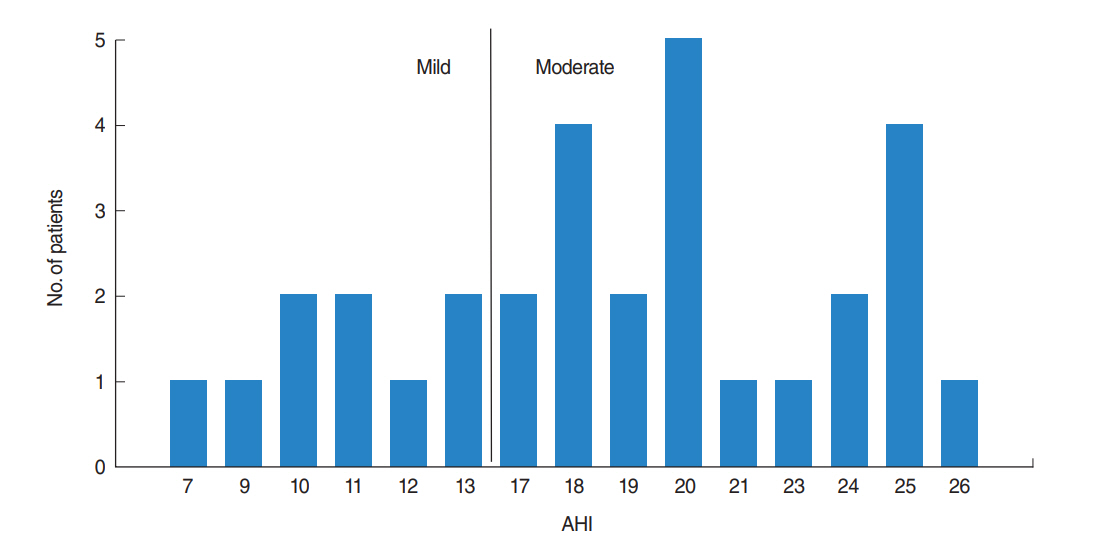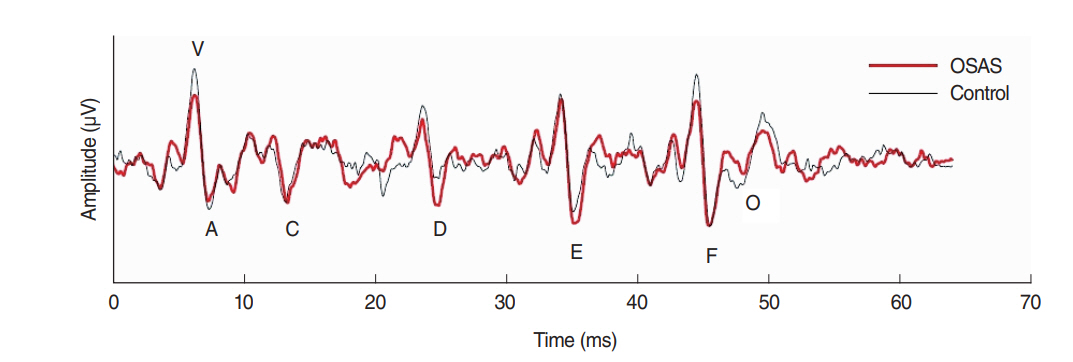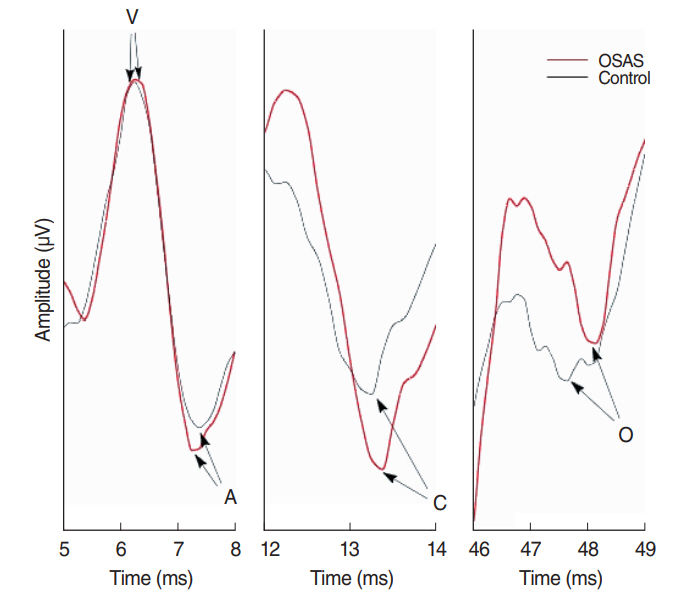Clin Exp Otorhinolaryngol.
2019 Feb;12(1):58-65. 10.21053/ceo.2018.00017.
Auditory Deficits in Patients With Mild and Moderate Obstructive Sleep Apnea Syndrome: A Speech Syllable Evoked Auditory Brainstem Response Study
- Affiliations
-
- 1Department of Otolaryngology, Guangdong Second Provincial General Hospital, Guangzhou, China. fqy98031@126.com
- 2Laboratory of Medical Data and Engineering, Shenzhen Technology University, Shenzhen, China.
- 3Department of Otolaryngology at Nanfang Hospital, Southern Medical University, Guangzhou, China.
- 4Department of Otolaryngology, The First People's Hospital of Kashi Area, Kashi, China.
- KMID: 2437492
- DOI: http://doi.org/10.21053/ceo.2018.00017
Abstract
OBJECTIVES
The energy consumption process of cochlea and neural signal transduction along the auditory pathway are highly dependent on blood oxygen supply. At present, it is under debate on whether the obstructive sleep apnea syndrome (OSAS) would affect the auditory function since the patients suffer from low oxygen saturation. Moreover, it is difficult to detect the functional state of auditory in less severe stage of OSAS. Recently, speech-evoked auditory brainstem response (speech-ABR) has been reported to be a new electrophysiological tool in characterizing the auditory dysfunction. The aim of the present study is to evaluate the auditory processes in adult patients with mild and moderate OSAS by speech-ABR.
METHODS
An experimental group of 31 patients with mild to moderate OSAS, and a control group without OSAS diagnosed by apnea hypopnea index in polysomnogram were recruited. All participants underwent otologic examinations and tests of pure-tone audiogram, distortion product otoacoustic emissions, click-evoked auditory brainstem response (click-ABR) and speech-ABR, respectively.
RESULTS
The results of pure-tone audiogram, distortion product otoacoustic emissions, and click-ABR in OSAS group showed no significant differences compared with the control group (P>0.05). Speech-ABRs for OSAS participants and controls showed similar morphological waveforms and typical peak structures. There were significant group differences for the onset and offset transient peaks (P < 0.05), where OSAS group had longer latencies for peak V (6.69± 0.33 ms vs. 6.39±0.23 ms), peak C (13.48±0.30 ms vs. 13.31±0.23 ms), and peak O (48.27±0.39 ms vs. 47.60± 0.40 ms) compared to the control group. The latency of these peaks showed significant correlations with apnea hypopnea index for peak V (r=0.37, P=0.040), peak C (r=0.36, P=0.045), as well as peak O (r=0.55, P=0.001).
CONCLUSION
These findings indicate that some auditory dysfunctions may be present in patients with mild and moderate OSAS, and the damages were aggravated with the severity of OSAS, which suggests that speech-ABR may be a potential biomarker in the diagnosis and evaluation at early stage of OSAS.
Keyword
MeSH Terms
Figure
Reference
-
1. Javaheri S, Parker TJ, Liming JD, Corbett WS, Nishiyama H, Wexler L, et al. Sleep apnea in 81 ambulatory male patients with stable heart failure: types and their prevalences, consequences, and presentations. Circulation. 1998; Jun. 97(21):2154–9.2. Inonu Koseoglu H, Kanbay A, Kokturk O. An important concomitancy: interstitial lung diseases and sleep related breathing disorders. Tuberk Toraks. 2014; 62(3):231–5.3. Hui DS, Wong TY, Ko FW, Li TS, Choy DK, Wong KK, et al. Prevalence of sleep disturbances in Chinese patients with end-stage renal failure on continuous ambulatory peritoneal dialysis. Am J Kidney Dis. 2000; Oct. 36(4):783–8.4. Das A, Anupa AV, Radhakrishnan A. Reduced plastic brain responses to repetitive transcranial magnetic stimulation in severe obstructive sleep apnea syndrome. Sleep Med. 2013; Jul. 14(7):636–40.
Article5. Arli B, Bilen S, Titiz AP, Ulusoy EK, Mungan S, Gurkas E, et al. Comparison of cognitive functions between obstructive sleep apnea syndrome and simple snoring patients: OSAS may be a modifiable risk factor for cognitive decline. Appl Neuropsychol Adult. 2015; 22(4):282–6.
Article6. Fanfulla F, Grassi M, Taurino AE, D’Artavilla Lupo N, Trentin R. The relationship of daytime hypoxemia and nocturnal hypoxia in obstructive sleep apnea syndrome. Sleep. 2008; Feb. 31(2):249–55.
Article7. Casale M, Vesperini E, Potena M, Pappacena M, Bressi F, Baptista PJ, et al. Is obstructive sleep apnea syndrome a risk factor for auditory pathway. Sleep Breath. 2012; Jun. 16(2):413–7.
Article8. Seo YJ, Kwak C, Kim S, Park YA, Park KH, Han W. Update on boneconduction auditory brainstem responses: a review. J Audiol Otol. 2018; Apr. 22(2):53–8.
Article9. Liu D, Chen Q, Huang Z, Zhong J, Zhou L. Auditory brainstem response in severe obstructive sleep apnea-hypopnea syndrome children. Lin Chuang Er Bi Yan Hou Ke Za Zhi. 2005; Oct. 19(19):868–70.10. Muchnik C, Rubel Y, Zohar Y, Hildesheimer M. Auditory brainstem response in obstructive sleep apnea patients. J Basic Clin Physiol Pharmacol. 1995; 6(2):139–48.
Article11. Wetmore SJ, Henderson C, Doshier NW, Milligan LB. Auditory brainstem response in obstructive sleep apnea. Laryngoscope. 1988; May. 98(5):499–501.
Article12. Karnaze D, Gott P, Mitchell F, Loftin J. Brainstem auditory evoked potentials are normal in idiopathic sleep apnea. Ann Neurol. 1984; Apr. 15(4):406.
Article13. Verma NP, Kapen S, King SD, Koshorek GJ. Bimodality electrophysiologic evaluation of brainstem in sleep apnea syndrome. Neurology. 1987; Jun. 37(6):1036–9.
Article14. Klatt DH. Software for a cascade/parallel formant synthesizer. J Acoust Soc Am. 1980; 67:971–95.
Article15. Johnson KL, Nicol TG, Kraus N. Brain stem response to speech: a biological marker of auditory processing. Ear Hear. 2005; Oct. 26(5):424–34.
Article16. Kraus N, Nicol T. Brainstem origins for cortical ‘what’ and ‘where’ pathways in the auditory system. Trends Neurosci. 2005; Apr. 28(4):176–81.
Article17. Purcell DW, John SM, Schneider BA, Picton TW. Human temporal auditory acuity as assessed by envelope following responses. J Acoust Soc Am. 2004; Dec. 116(6):3581–93.
Article18. King C, Warrier CM, Hayes E, Kraus N. Deficits in auditory brainstem pathway encoding of speech sounds in children with learning problems. Neurosci Lett. 2002; Feb. 319(2):111–5.
Article19. Wible B, Nicol T, Kraus N. Atypical brainstem representation of onset and formant structure of speech sounds in children with languagebased learning problems. Biol Psychol. 2004; Nov. 67(3):299–317.
Article20. Banai K, Nicol T, Zecker SG, Kraus N. Brainstem timing: implications for cortical processing and literacy. J Neurosci. 2005; Oct. 25(43):9850–7.
Article21. Wible B, Nicol T, Kraus N. Correlation between brainstem and cortical auditory processes in normal and language-impaired children. Brain. 2005; Feb. 128(Pt 2):417–23.
Article22. Tahaei AA, Ashayeri H, Pourbakht A, Kamali M. Speech evoked auditory brainstem response in stuttering. Scientifica (Cairo). 2014; 2014:328646.
Article23. Chung SA, Yuan H, Chung F. A systemic review of obstructive sleep apnea and its implications for anesthesiologists. Anesth Analg. 2008; Nov. 107(5):1543–63.
Article24. American Academy of Sleep Medicine. International classification of sleep disorders: diagnostic and coding manual. 2nd ed. Westchester (IL): American Academy of Sleep Medicine;2005.25. Guideline for the diagnosis and surgical treatment of obstructive sleep apnea hypopnea syndrome. Zhonghua Er Bi Yan Hou Tou Jing Wai Ke Za Zhi. 2009; Feb. 44(2):95–6.26. Yuvaraj P, Jayaram M. Audiological profile of adult persons with auditory neuropathy spectrum disorders. J Audiol Otol. 2016; Dec. 20(3):158–67.
Article27. Song JH, Banai K, Russo NM, Kraus N. On the relationship between speech- and nonspeech-evoked auditory brainstem responses. Audiol Neurootol. 2006; Jun. 11(4):233–41.
Article28. Murphy CB, Peres AK, Zachi EC, Ventura DF, Pagan-Neves L, Wertzner HF, et al. Generalization of sensory auditory learning to top-down skills in a randomized controlled trial. J Am Acad Audiol. 2015; Jan. 26(1):19–29.
Article29. Masuda S, Takeuchi K, Tsuruoka H, Ukai K, Sakakura Y. Word deafness after resection of a pineal body tumor in the presence of normal wave latencies of the auditory brain stem response. Ann Otol Rhinol Laryngol. 2000; Dec. 109(12 Pt 1):1107–12.
Article30. Russo N, Nicol T, Musacchia G, Kraus N. Brainstem responses to speech syllables. Clin Neurophysiol. 2004; Sep. 115(9):2021–30.
Article31. Akhoun I, Gallego S, Moulin A, Menard M, Veuillet E, Berger-Vachon C, et al. The temporal relationship between speech auditory brainstem responses and the acoustic pattern of the phoneme /ba/ in normal-hearing adults. Clin Neurophysiol. 2008; Apr. 119(4):922–33.
Article32. Song JH, Skoe E, Banai K, Kraus N. Perception of speech in noise: neural correlates. J Cogn Neurosci. 2011; Sep. 23(9):2268–79.
Article33. Vander Werff KR, Burns KS. Brain stem responses to speech in younger and older adults. Ear Hear. 2011; Mar-Apr. 32(2):168–80.
Article34. el-Kady MA, Durrant JD, Tawfik S, Abdel-Ghany S, Moussa AM. Study of auditory function in patients with chronic obstructive pulmonary diseases. Hear Res. 2006; Feb. 212(1-2):109–16.
Article35. Johnson KL, Nicol TG, Zecker SG, Kraus N. Auditory brainstem correlates of perceptual timing deficits. J Cogn Neurosci. 2007; Mar. 19(3):376–85.
Article36. Faure PA, Fremouw T, Casseday JH, Covey E. Temporal masking reveals properties of sound-evoked inhibition in duration-tuned neurons of the inferior colliculus. J Neurosci. 2003; Apr. 23(7):3052–65.
Article37. Skoe E, Kraus N. Auditory brain stem response to complex sounds: a tutorial. Ear Hear. 2010; Jun. 31(3):302–24.
Article38. Clinard CG, Tremblay KL, Krishnan AR. Aging alters the perception and physiological representation of frequency: evidence from human frequency-following response recordings. Hear Res. 2010; Jun. 264(1-2):48–55.
Article
- Full Text Links
- Actions
-
Cited
- CITED
-
- Close
- Share
- Similar articles
-
- Brainstem Auditory Evoked Potential in a Case of Severe Carbon Monoxide Intoxication
- Brainstem Correlates of Comodulation Masking Release for Speech in Normal Hearing Adults
- Computer Generated Three-Dimensional Reconstruction of the Auditory Pathway Structures of Brainstem
- Auditory Neuropathy: A Report of Three Cases
- Sound-Field Speech Evoked Auditory Brainstem Responsein Cochlear-Implant Recipients




